Hyundai Santa Fe Sport 2015 Owner's Manual
Manufacturer: HYUNDAI, Model Year: 2015, Model line: Santa Fe Sport, Model: Hyundai Santa Fe Sport 2015Pages: 785, PDF Size: 13.38 MB
Page 771 of 785
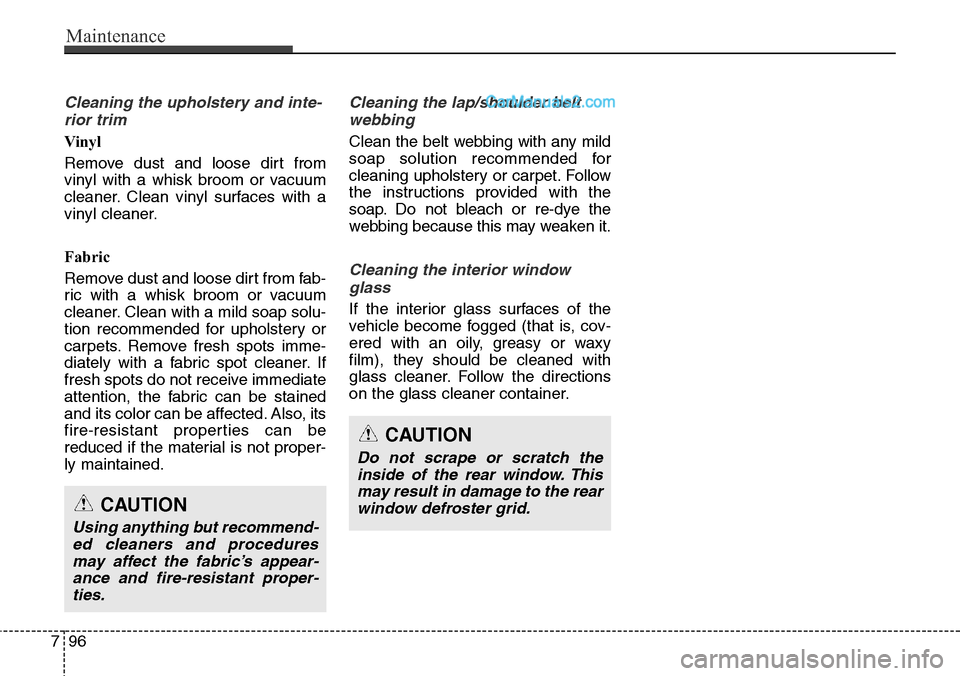
Maintenance
96 7
Cleaning the upholstery and inte-
rior trim
Vinyl
Remove dust and loose dirt from
vinyl with a whisk broom or vacuum
cleaner. Clean vinyl surfaces with a
vinyl cleaner.
Fabric
Remove dust and loose dirt from fab-
ric with a whisk broom or vacuum
cleaner. Clean with a mild soap solu-
tion recommended for upholstery or
carpets. Remove fresh spots imme-
diately with a fabric spot cleaner. If
fresh spots do not receive immediate
attention, the fabric can be stained
and its color can be affected. Also, its
fire-resistant properties can be
reduced if the material is not proper-
ly maintained.
Cleaning the lap/shoulder belt
webbing
Clean the belt webbing with any mild
soap solution recommended for
cleaning upholstery or carpet. Follow
the instructions provided with the
soap. Do not bleach or re-dye the
webbing because this may weaken it.
Cleaning the interior window
glass
If the interior glass surfaces of the
vehicle become fogged (that is, cov-
ered with an oily, greasy or waxy
film), they should be cleaned with
glass cleaner. Follow the directions
on the glass cleaner container.
CAUTION
Do not scrape or scratch the
inside of the rear window. This
may result in damage to the rear
window defroster grid.
CAUTION
Using anything but recommend-
ed cleaners and procedures
may affect the fabric’s appear-
ance and fire-resistant proper-
ties.
Page 772 of 785
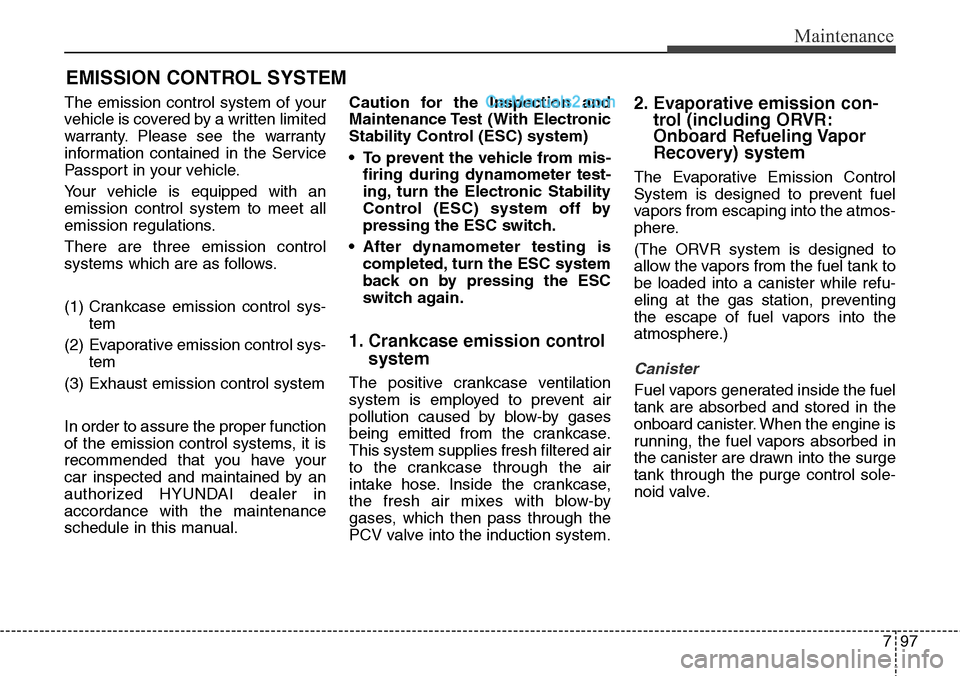
797
Maintenance
EMISSION CONTROL SYSTEM
The emission control system of your
vehicle is covered by a written limited
warranty. Please see the warranty
information contained in the Service
Passport in your vehicle.
Your vehicle is equipped with an
emission control system to meet all
emission regulations.
There are three emission control
systems which are as follows.
(1) Crankcase emission control sys-
tem
(2) Evaporative emission control sys-
tem
(3) Exhaust emission control system
In order to assure the proper function
of the emission control systems, it is
recommended that you have your
car inspected and maintained by an
authorized HYUNDAI dealer in
accordance with the maintenance
schedule in this manual.Caution for the Inspection and
Maintenance Test (With Electronic
Stability Control (ESC) system)
• To prevent the vehicle from mis-
firing during dynamometer test-
ing, turn the Electronic Stability
Control (ESC) system off by
pressing the ESC switch.
• After dynamometer testing is
completed, turn the ESC system
back on by pressing the ESC
switch again.
1. Crankcase emission control
system
The positive crankcase ventilation
system is employed to prevent air
pollution caused by blow-by gases
being emitted from the crankcase.
This system supplies fresh filtered air
to the crankcase through the air
intake hose. Inside the crankcase,
the fresh air mixes with blow-by
gases, which then pass through the
PCV valve into the induction system.
2. Evaporative emission con-
trol (including ORVR:
Onboard Refueling Vapor
Recovery) system
The Evaporative Emission Control
System is designed to prevent fuel
vapors from escaping into the atmos-
phere.
(The ORVR system is designed to
allow the vapors from the fuel tank to
be loaded into a canister while refu-
eling at the gas station, preventing
the escape of fuel vapors into the
atmosphere.)
Canister
Fuel vapors generated inside the fuel
tank are absorbed and stored in the
onboard canister. When the engine is
running, the fuel vapors absorbed in
the canister are drawn into the surge
tank through the purge control sole-
noid valve.
Page 773 of 785
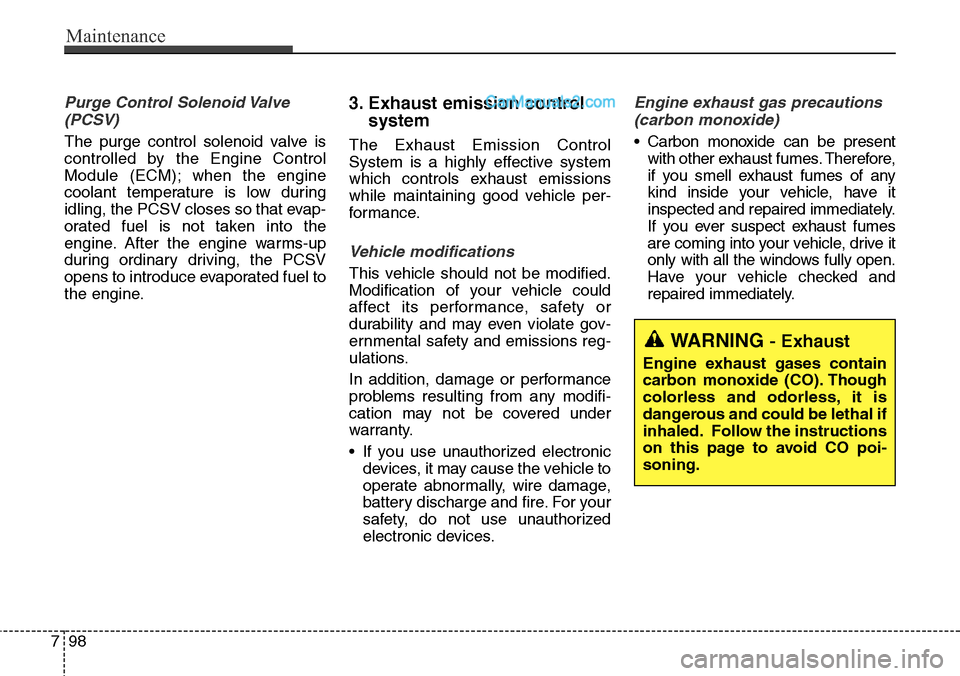
Maintenance
98 7
Purge Control Solenoid Valve
(PCSV)
The purge control solenoid valve is
controlled by the Engine Control
Module (ECM); when the engine
coolant temperature is low during
idling, the PCSV closes so that evap-
orated fuel is not taken into the
engine. After the engine warms-up
during ordinary driving, the PCSV
opens to introduce evaporated fuel to
the engine.
3. Exhaust emission control
system
The Exhaust Emission Control
System is a highly effective system
which controls exhaust emissions
while maintaining good vehicle per-
formance.
Vehicle modifications
This vehicle should not be modified.
Modification of your vehicle could
affect its performance, safety or
durability and may even violate gov-
ernmental safety and emissions reg-
ulations.
In addition, damage or performance
problems resulting from any modifi-
cation may not be covered under
warranty.
• If you use unauthorized electronic
devices, it may cause the vehicle to
operate abnormally, wire damage,
battery discharge and fire. For your
safety, do not use unauthorized
electronic devices.
Engine exhaust gas precautions
(carbon monoxide)
• Carbon monoxide can be present
with other exhaust fumes. Therefore,
if you smell exhaust fumes of any
kind inside your vehicle, have it
inspected and repaired immediately.
If you ever suspect exhaust fumes
are coming into your vehicle, drive it
only with all the windows fully open.
Have your vehicle checked and
repaired immediately.
WARNING - Exhaust
Engine exhaust gases contain
carbon monoxide (CO). Though
colorless and odorless, it is
dangerous and could be lethal if
inhaled. Follow the instructions
on this page to avoid CO poi-
soning.
Page 774 of 785
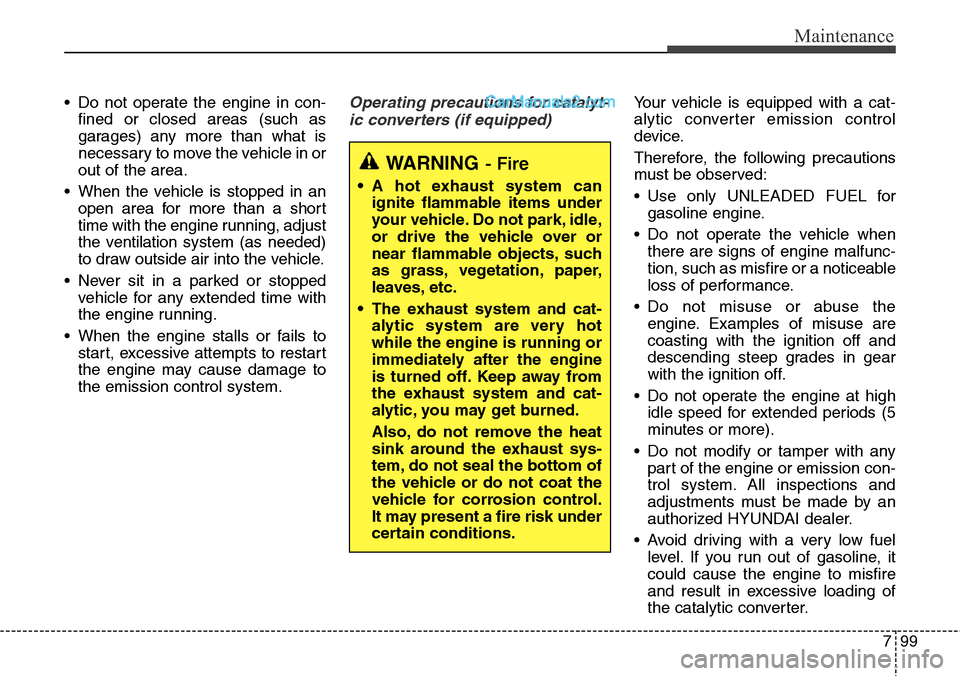
799
Maintenance
• Do not operate the engine in con-
fined or closed areas (such as
garages) any more than what is
necessary to move the vehicle in or
out of the area.
• When the vehicle is stopped in an
open area for more than a short
time with the engine running, adjust
the ventilation system (as needed)
to draw outside air into the vehicle.
• Never sit in a parked or stopped
vehicle for any extended time with
the engine running.
• When the engine stalls or fails to
start, excessive attempts to restart
the engine may cause damage to
the emission control system.Operating precautions for catalyt-
ic converters (if equipped)Your vehicle is equipped with a cat-
alytic converter emission control
device.
Therefore, the following precautions
must be observed:
• Use only UNLEADED FUEL for
gasoline engine.
• Do not operate the vehicle when
there are signs of engine malfunc-
tion, such as misfire or a noticeable
loss of performance.
• Do not misuse or abuse the
engine. Examples of misuse are
coasting with the ignition off and
descending steep grades in gear
with the ignition off.
• Do not operate the engine at high
idle speed for extended periods (5
minutes or more).
• Do not modify or tamper with any
part of the engine or emission con-
trol system. All inspections and
adjustments must be made by an
authorized HYUNDAI dealer.
• Avoid driving with a very low fuel
level. If you run out of gasoline, it
could cause the engine to misfire
and result in excessive loading of
the catalytic converter.
WARNING- Fire
• A hot exhaust system can
ignite flammable items under
your vehicle. Do not park, idle,
or drive the vehicle over or
near flammable objects, such
as grass, vegetation, paper,
leaves, etc.
• The exhaust system and cat-
alytic system are very hot
while the engine is running or
immediately after the engine
is turned off. Keep away from
the exhaust system and cat-
alytic, you may get burned.
Also, do not remove the heat
sink around the exhaust sys-
tem, do not seal the bottom of
the vehicle or do not coat the
vehicle for corrosion control.
It may present a fire risk under
certain conditions.
Page 775 of 785
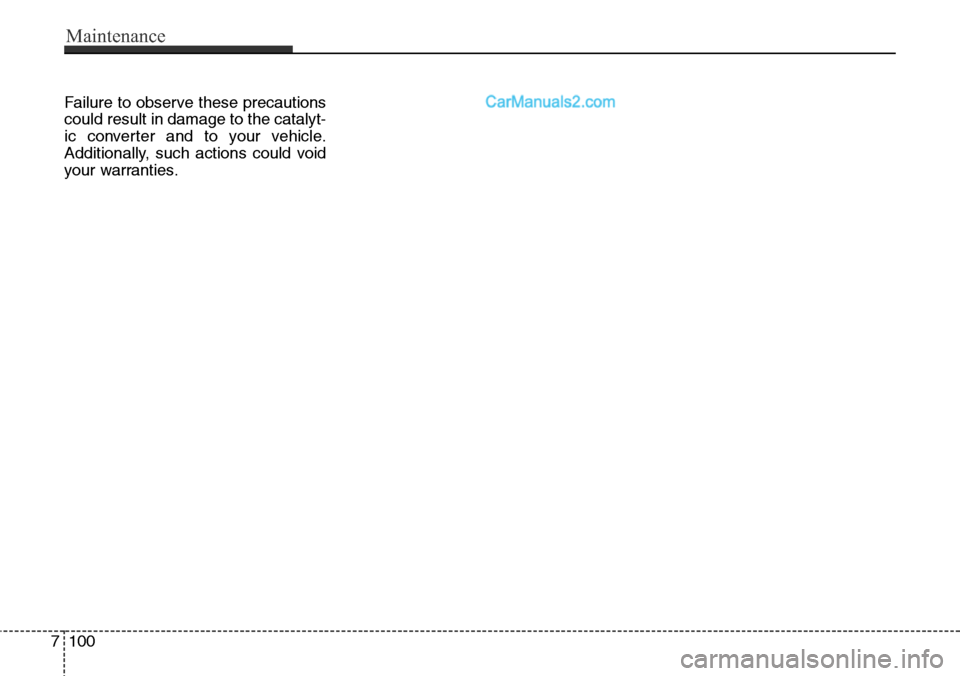
Failure to observe these precautions
could result in damage to the catalyt-
ic converter and to your vehicle.
Additionally, such actions could void
your warranties.
7100
Maintenance
Page 776 of 785
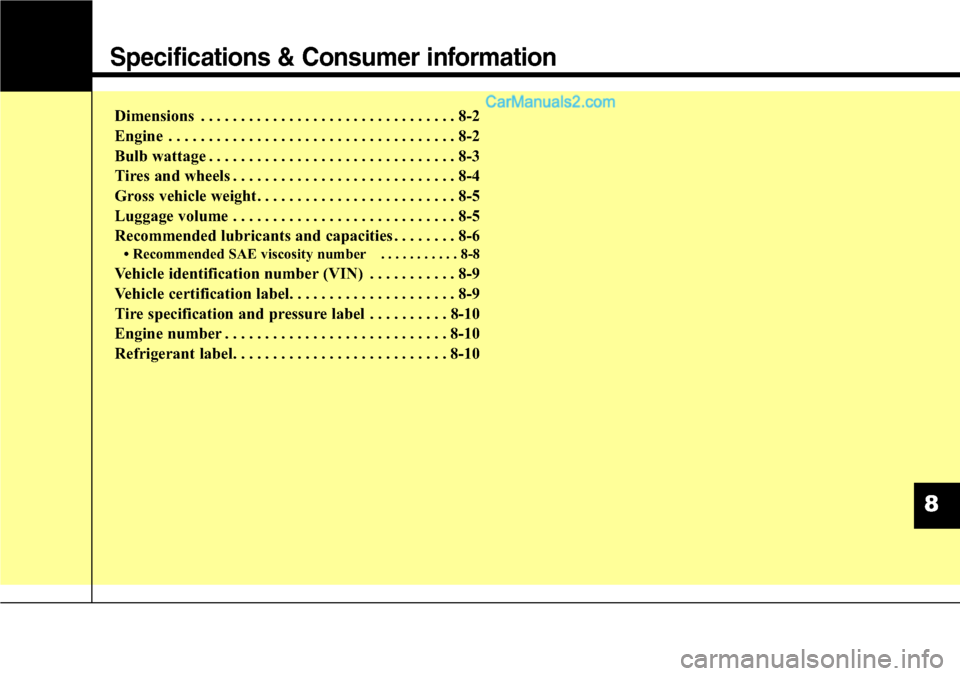
Specifications & Consumer information
Dimensions . . . . . . . . . . . . . . . . . . . . . . . . . . . . . . . . 8-2
Engine . . . . . . . . . . . . . . . . . . . . . . . . . . . . . . . . . . . . 8-2
Bulb wattage . . . . . . . . . . . . . . . . . . . . . . . . . . . . . . . 8-3
Tires and wheels . . . . . . . . . . . . . . . . . . . . . . . . . . . . 8-4
Gross vehicle weight. . . . . . . . . . . . . . . . . . . . . . . . . 8-5
Luggage volume . . . . . . . . . . . . . . . . . . . . . . . . . . . . 8-5
Recommended lubricants and capacities . . . . . . . . 8-6
• Recommended SAE viscosity number . . . . . . . . . . . 8-8
Vehicle identification number (VIN) . . . . . . . . . . . 8-9
Vehicle certification label. . . . . . . . . . . . . . . . . . . . . 8-9
Tire specification and pressure label . . . . . . . . . . 8-10
Engine number . . . . . . . . . . . . . . . . . . . . . . . . . . . . 8-10
Refrigerant label. . . . . . . . . . . . . . . . . . . . . . . . . . . 8-10
8
8
Page 777 of 785
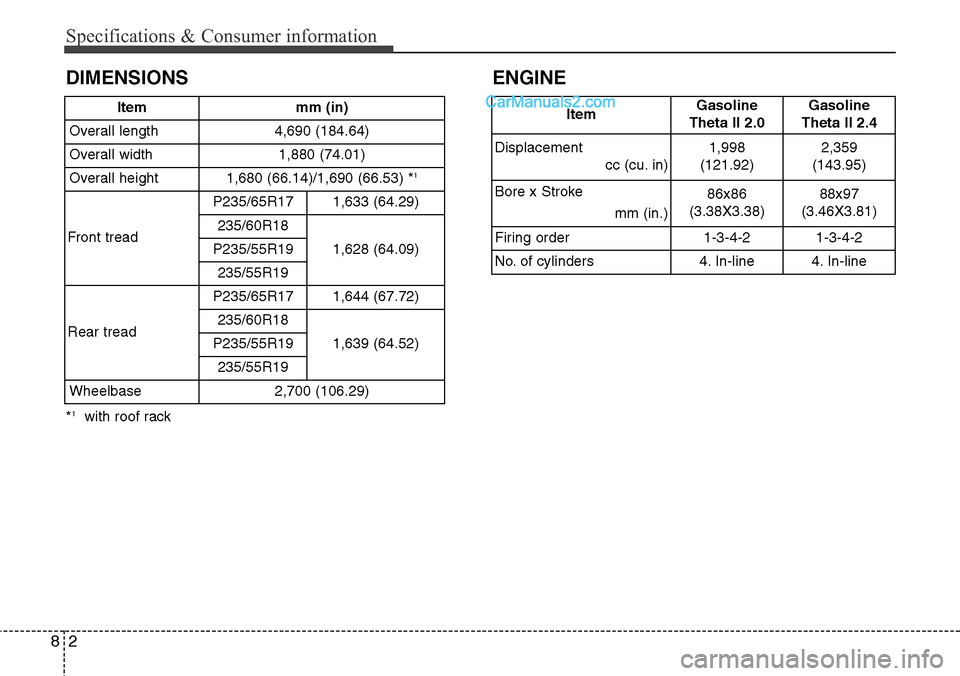
Specifications & Consumer information
2 8
DIMENSIONS
*1with roof rackItem mm (in)
Overall length 4,690 (184.64)
Overall width 1,880 (74.01)
Overall height 1,680 (66.14)/1,690 (66.53) *
1
Front treadP235/65R17 1,633 (64.29)235/60R18
1,628 (64.09)P235/55R19
235/55R19
Rear tread
P235/65R171,644 (67.72)
235/60R18
1,639 (64.52) P235/55R19
235/55R19
Wheelbase 2,700 (106.29)
ItemGasoline
Theta II 2.0Gasoline
Theta II 2.4
Displacement
cc (cu. in)
1,998
(121.92)2,359
(143.95)
Bore x Stroke
mm (in.)
86x86
(3.38X3.38)88x97
(3.46X3.81)
Firing order
1-3-4-2 1-3-4-2
No. of cylinders
4. In-line 4. In-line
ENGINE
Page 778 of 785
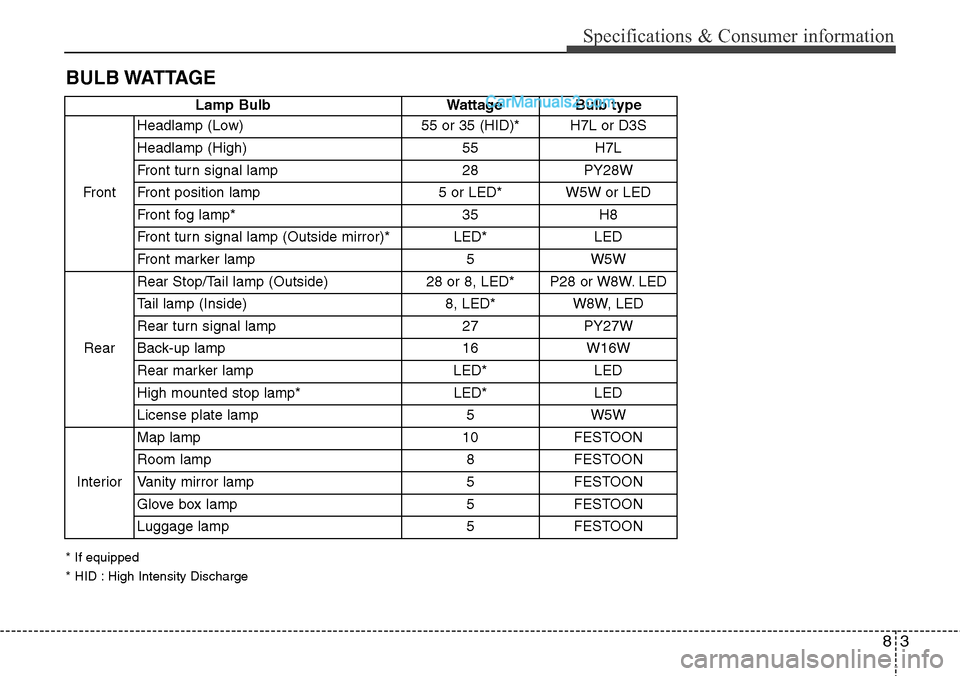
83
Specifications & Consumer information
BULB WATTAGE
Lamp Bulb Wattage Bulb type
FrontHeadlamp (Low) 55 or 35 (HID)* H7L or D3S
Headlamp (High) 55 H7L
Front turn signal lamp 28 PY28W
Front position lamp 5 or LED* W5W or LED
Front fog lamp* 35 H8
Front turn signal lamp (Outside mirror)* LED* LED
Front marker lamp 5 W5W
RearRear Stop/Tail lamp (Outside) 28 or 8, LED* P28 or W8W. LED
Tail lamp (Inside) 8, LED* W8W, LED
Rear turn signal lamp 27 PY27W
Back-up lamp 16 W16W
Rear marker lamp LED* LED
High mounted stop lamp* LED* LED
License plate lamp 5 W5W
InteriorMap lamp 10 FESTOON
Room lamp 8 FESTOON
Vanity mirror lamp 5 FESTOON
Glove box lamp 5 FESTOON
Luggage lamp 5 FESTOON
* If equipped
* HID : High Intensity Discharge
Page 779 of 785
![Hyundai Santa Fe Sport 2015 Owners Manual Specifications & Consumer information
4 8
TIRES AND WHEELS
Item Tire size Wheel sizeInflation pressure [kPa (psi)]
Wheel lug nut torque
kg•m (lb•ft, N•m) Normal load
()Maximum load
()
Front Re Hyundai Santa Fe Sport 2015 Owners Manual Specifications & Consumer information
4 8
TIRES AND WHEELS
Item Tire size Wheel sizeInflation pressure [kPa (psi)]
Wheel lug nut torque
kg•m (lb•ft, N•m) Normal load
()Maximum load
()
Front Re](/img/35/16759/w960_16759-778.png)
Specifications & Consumer information
4 8
TIRES AND WHEELS
Item Tire size Wheel sizeInflation pressure [kPa (psi)]
Wheel lug nut torque
kg•m (lb•ft, N•m) Normal load
()Maximum load
()
Front Rear Front Rear
Full size tireP235/65R17 7.0J×17
235
(34)235
(34)235
(34)235
(34)
9~11
(65~79, 88~107) 235/60R18 7.5J×18
P235/55R19 7.5J×19
235/55R19 7.5J×19
Compact spare tire
(if equipped)T165/90D17 4.0T×17420
(60)420
(60)420
(60)420
(60)
CAUTION
When replacing tires, use the same size originally supplied with the vehicle.
Using tires of a different size can damage the related parts or make it work
irregularly.
Page 780 of 785
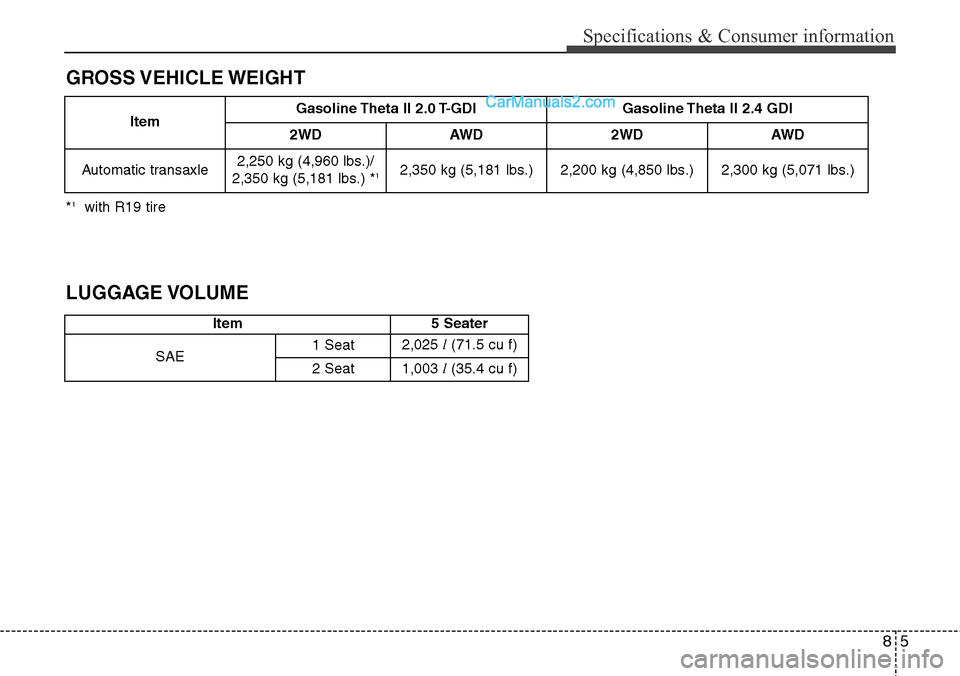
85
Specifications & Consumer information
GROSS VEHICLE WEIGHT
LUGGAGE VOLUME
Item 5 Seater
SAE1 Seat2,025 l(71.5 cu f)
2 Seat1,003 l(35.4 cu f)
ItemGasoline Theta II 2.0 T-GDI Gasoline Theta II 2.4 GDI
2WD AWD 2WD AWD
Automatic transaxle2,250 kg (4,960 lbs.)/
2,350 kg (5,181 lbs.) *
12,350 kg (5,181 lbs.) 2,200 kg (4,850 lbs.) 2,300 kg (5,071 lbs.)
*1with R19 tire